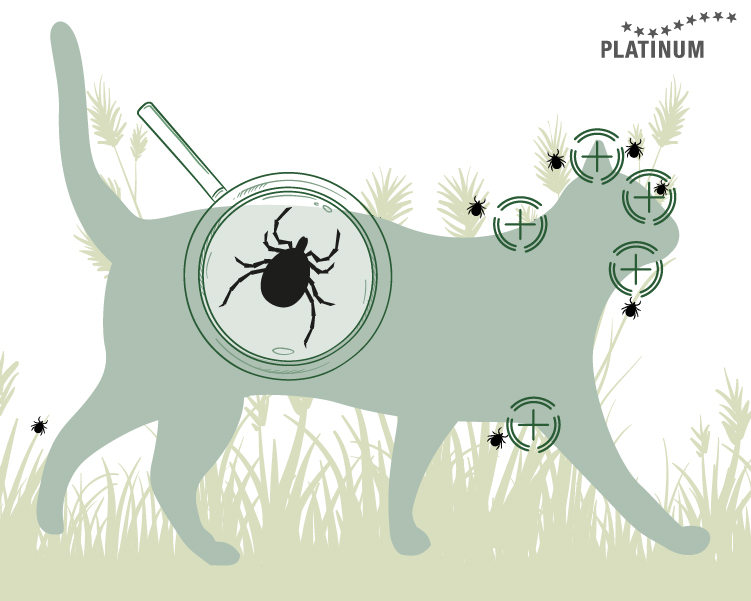Ticks in cats – how to properly protect your cat
Cats need
our help to stay tick-free. Because once ticks settle on them, they also get
into the fur and anchor themselves there. Ticks aren’t just annoying for house
cats – they can also transmit diseases. We will explain exactly what these are
and how you can best protect your cat from ticks and any secondary diseases in
the following guide.
When is tick season?
Tick season
isn’t limited to a particular time of year. It’s a common misconception that
tick season starts in spring when the weather starts getting a bit milder –
tick season is actually all year round. The risk of getting a tick bite has
increased to almost all year round thanks to climate change and new types of
ticks. The Dermacentor is active at outside temperatures ranging as low as 7°C,
which is why it is found in many regions from January to December. The wood
tick, on the other hand, is usually only active between March to June and
September to November. That’s why many cat owners use special products to
protect house cats that are outside from February to November to prevent
diseases caused by tick bites.

Ticks can transmit various diseases
If you’re a
dog owner, you probably deal with the little parasites every year. Although
cats are less likely to have ticks than dogs, for example, they aren’t
completely spared from the bloodsucking parasites. Most ticks are found on cats
by accident when petting them. Or when the engorged tick falls off and crawls
away.
The tick
looks for a good place on its host to bite. Depending on the type of tick,
blood can be sucked for two to ten days. In cats, ticks are often found behind
the ears, on the neck and between the legs. A tick bite often appears on the
surface of the skin. The tick uses its mouthparts to do this. Two ‘fingers’,
which are relatively small, flexible and have sharp edges, are located at the
tip. The parasite cuts into the skin by moving these. Then the tick sinks its
mouthparts – built like proboscises – into the host’s skin and the tissue next
to the skin and secretes saliva. This may contain pathogens, because not all
ticks necessarily carry bacteria, thus posing a risk of infection.
Serious
diseases caused by ticks include Lyme disease and anaplasmosis, which in
Germany are mainly transmitted to cats via two types of hard ticks – the wood
tick and the Dermacentor. In southern Europe, other infectious diseases can be
transmitted via the brown dog tick, which can also be found on cats. These
include tularaemia and ehrlichiosis. The brown dog tick is active all year
round but can’t survive in low temperatures. In contrast to the native tick
species, however, it can survive very well indoors, which is why it can also be
found here, especially in animal shelters or animal sanctuaries.
If the cat
is affected by a tick-borne disease, it often shows symptoms like loss of
appetite, fever or lameness that cannot be clearly attributed to a specific
disease. So, it’s really difficult for a layperson to recognise diseases that
stem from a tick bite.
Lyme disease and TBE in cats
The two
most well-known diseases caused by tick bites are Lyme disease and tick-borne
encephalitis (TBE for short). The former, also known as borreliosis, is caused
by the bacterium Borrelia burgdorferi. Tick bites cause local inflammation.
Skin reddening, which spreads out in a ring shape around the bite, is usually
covered by the cat’s fur, so general symptoms of diseases only become apparent
weeks after infection.
Symptoms of
Lyme disease include bouts of fever, loss of appetite and lameness that
alternates between legs. In some cases, pathogens can also damage joints or
even attack the central nervous system. In these cases, there is a risk of
permanent damage, and the disease may also continue to flare up. The only way
of determining the cause of the problem is to go to a vet straight away. The
vet will run blood tests and then make a diagnosis. If the results are positive
for a tick-borne disease, the vet will then treat it with antibiotics.

TBE, caused
by a TBE virus infection, is really minor in cats. Humans, dogs and horses
experience increased sensitivity to pain, seizures and gait disorders – based
on the current information available, cats seem to be immune to this, but could
bring home infected ticks.

Cats cannot
be vaccinated against TBE or Lyme disease. Preventative measures thus differ
compared to humans and dogs.
Anaplasmosis in cats
In Germany,
anaplasmosis is transmitted by the common wood tick. Anaplasma are bacteria
that attack white blood cells. Symptoms of anaplasmosis include fever,
lethargy, pale mucous membranes, joint pain and weight loss. Haemorrhages and
lameness have also been found in isolated cases. Vets can run blood tests and
make a diagnosis. Similar to Lyme disease, it is then treated with antibiotics.
However, reports of anaplasma infections in cats are rare.
What helps to protect against ticks in cats?
The risk of
a tick infestation in a cat depends on a number of factors. The most important
factor is whether your cat is an indoor cat or an outdoor cat, and whether you
are located in a risk area for certain types of ticks. If your cat regularly
goes outside, the best protection against ticks and the diseases they can
transmit is a combination of tick protection products and thorough daily
checks. You can consult your vet for appropriate treatments that have been
tested in terms of effectiveness and tolerability.
Special tick protection treatments
‘Spot-ons’
are sprayed or dropped onto the cat’s neck. Many products also come with a
small pipette so that the drops can be applied in a targeted way. The active
ingredients are then absorbed through the upper layer of the skin. Ticks that
come into contact with the active ingredient are killed. The neck is
particularly popular with spot-on treatments, as cats then can’t lick the drops
away when cleaning. You should also make sure that other animals do not lick
the treatment. Important: Make sure the product is also suitable for cats.
Spot-on treatments are available for dogs, but these are dangerous for cats!
It’s best to consult your vet beforehand.
Sprays work just as well as spot-on
treatments.
Pills to protect cats against ticks are
also available from vets.
And collars
with tick protection are also available. These continuously release the active
ingredients and usually ward off ticks and other parasites over a longer period
of time (up to six months). However, they can pose a considerable risk of
injury, as cats can get caught in the collar, resulting in risk of
strangulation. That’s why you should make sure that these collars have a set
breaking point or special safety lock to make sure that nothing bad happens if
your cat gets caught.
All these
treatments only prevent the transmission of diseases, as ticks die as soon as
they bite. However, this does not prevent ticks from coming into your home on
your cat. A tick that is not yet attached to an animal can easily pass from cat
to human through close contact like petting.
Natural tick repellents
Coconut
oil, black cumin oil, garlic and amber – these home remedies are suggested time
and again to help protect against ticks in cats. These
home remedies are particularly popular among dog owners, but a lot of cat
owners now also use coconut oil regularly. It’s generally easy to apply,
as our body heat turns it into a liquid, meaning it can be rubbed in very
easily. However, a lot of cats are also very suspicious of the film of oil on
their fur, which causes them to start cleaning excessively. This grooming won’t
do anything from a health perspective, but the cat will no longer be protected
against ticks.
Cat owners
also like to use brewer’s yeast which is a natural tick repellent. Taking
brewer’s yeast daily is said to change the cat’s skin properties, keeping ticks
away. This is because the B vitamins it contains help to change the cat’s body
odour. Brewer’s yeast is available as a powder or in pill form, which can be
given to the cat as a treat or crumbled up and mixed with food. Brewer’s yeast
to protect against ticks is said to take effect after just one week.
Caution is
advised when using certain oils like tea tree oil. Cat owners should be careful
with these. The German Federal Institute for Risk Assessment warns of severe
symptoms of poisoning in cats. Compared to humans and dogs, they can’t really
break down and excrete the terpenes and phenols they contain, making them very
sensitive to them.
Checking fur and regularly checking your cat
If your cat
is an outdoor cat, you should check your four-legged friend for ticks regularly
– at least once a day, ideally. Pay particular attention to the areas ticks
prefer – places with little fur and good blood circulation, like the head,
chin, ears and inner legs. It is exactly places like these that the parasites
like to take root. Ticks are easily missed in fur. Especially if they aren’t
engorged yet. Stroke and brush your cat well and pay attention to lumps and
bumps or other unfamiliar spots. If the cat allows it, you can – just once –
stroke them in the opposite direction of their fur growth. This will allow you
to get a better look at their skin.
Depending
on how long the tick has been on the cat and how much blood it has sucked, it
will vary in size from a few millimetres to the size of a cherry stone. Parasites
that are already firmly fixed must be removed as bacteria and viruses can even
be transmitted after many hours. Early tick removal can provide effective
protection. Monitor the site of the bite for some time even after removal.
Redness, fever or loss of appetite could indicate that your cat may be ill.
With a tick bite, there is always a very high risk of a disease being
transmitted to the cat. That’s why you should completely protect against ticks
if there is a risk.

How should I properly remove a tick from my cat?
It’s
important that you’re calm and careful when removing a tick. Unfortunately –
and unlike dogs – cats hardly ever sit still. If your feline fights back, then
you should get someone to help you. Because, as a worst-case scenario, your cat
could be injured by the tweezers, or the parasite only partially removed
because your cat has escaped. This is not usually an easy task for cat owners
either, because many often have to throw in the towel covered in scratches and
bites after trying to hold their cat. As a cat owner, you know your animal best
and will know how to calm them down. Some cats can be coaxed, while others can
be distracted with a treat. There are even cats who like staying still while
ticks are being removed. After all, these parasites are also unpleasant for the
cat.
Before
removing a tick from a cat, you should push back any surrounding fur.
Otherwise, you’ll unnecessarily tear out the cat’s fur. Special tools are
available that are narrow at the front in order to protect the fur. On cats,
it’s best not to use tick cards or levers like those available for humans.
Don’t remove the tick with your bare hands either. Here, there is a risk that
the parasite will be crushed, releasing pathogens into the bite site. In the
best-case scenario, you’re using special tick tweezers and are able to grab the
tick directly on the cat’s skin. When pulling, make sure not to rotate the
tweezers. This can lead to parts of the tick tearing off and remaining in the
bite site, which can then lead to inflammation. Slowly pull the tick out in a
straight line. The tick can be slowly detached and be removed in full. Keep
tick bites in the back of your mind for next time. If your cat seems under the
weather, listless, or develops a fever, contact your vet immediately.
Frequently asked questions about ticks in cats
What should I do with the tick after removing it?
Ticks are
very tough. Most ticks continue to live happily after removal. So, you should
definitely dispose of them. Otherwise, your cat or another four-legged friend
might bring them back into the house again on the next occasion. Ticks can live
happily for a long time underwater, meaning it’s also not a good idea to
dispose of ticks down the toilet or kitchen sink. The safer option is to put
the bloodsucker into high-proof alcohol (> 40%), a chlorine cleaning agent
or disinfectant, or to crush it – but don’t crush it with your bare hands. Use
a flat, hard object.
What should I do after removing a tick from my cat if the head is still intact?
Remnants of
ticks can sometimes get stuck in the cat’s skin. If the remains of its biting
part are involved, the skin usually sheds these naturally after a few days. But
if the tick head gets stuck, it should be removed as soon as possible. Because
this still carries the risk of pathogen transmission. The general advice is to
check the bite site regularly. If you spot any signs of inflammation, you
should consult your vet.
Where can I buy tick repellent?
There are
now many preventative tick treatments for cats. You should get pills and
special spot-on treatments or sprays from a vet. You can also buy some
treatments online, in pharmacies or in pet shops. You can also find natural
remedies in retail stores.
Where do cats get ticks from?
Outdoor
cats love spending time in forests and meadows. They hunt, explore, or just
laze about and sunbathe. And when they do, they inevitably come into contact
with ticks. The parasites mainly perch in bushes or in tall grass, waiting for
their next host.
Can diseases like Lyme disease or TBE be transmitted from cats to humans?
No,
diseases caused by a tick bite in cats cannot be directly transmitted to
humans. However, cats or other pets can bring home infected ticks that can be
passed on to humans – when petting them, for example. Of course, diseases like
Lyme disease or TBE can then be transmitted directly by the tick. So, with tick
prevention and removal, you’re not just protecting your kitty – you’re
protecting yourself too.


 Deutsch
Deutsch
 English
English
 Nederlands
Nederlands
 Français
Français






.png)
.png)
.png)

